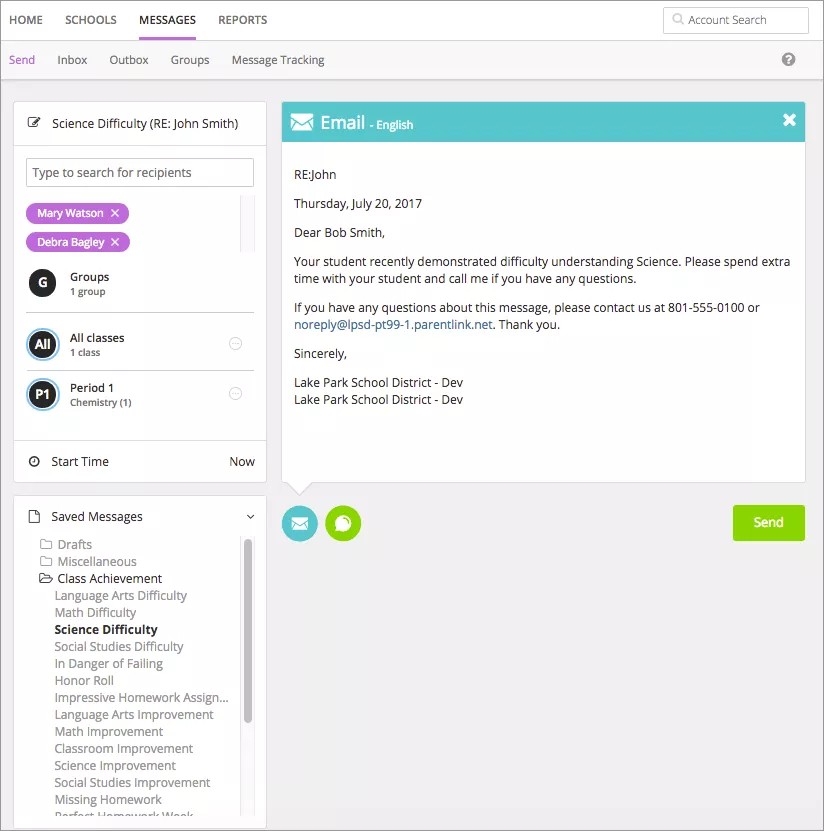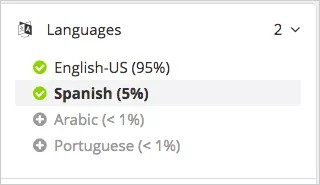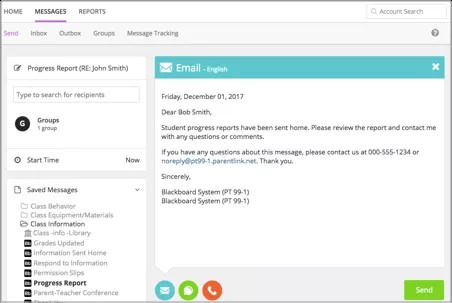Communicate effectively.
Your school's website includes a simple-to-use notification system that is designed for teachers — Teacher Communications. You can send messages to any of your students, the entire class, all your classes, or just to parents. Plus, Teacher Communications allows you to send pre-made messages. These messages are categorized into teacher specific categories and can be targeted to select students based on the message subject. You can also create your own message.
Check it out!
Send my own message
If you want to create your own message instead of sending a pre-made message, you can type your own content in Send Message page. You can then select to send it as an email, text/SMS message, or if set by your school, as a phone message.
- Select Messages.
Each teacher's students are separated into classes.
- Select the class or a user group.
Is there a group of students or parents that you contact on a regular basis? Create a special user group!
- To send a message to one or a few members, select the specific users. You can select all parents or all students, or use the list icon to select individual users. You can also search for specific users by name.
- Type the Subject.
- Select one or more delivery methods from the main send message page to send to the recipients:
- Emails - Type your text and add any images. To remove the email option, close out the tab from the upper right hand corner.
- Text/SMS - Content needs to be less than 160 characters. To copy content from the email message, select the Copy Content icon. To remove the text/SMS option, close out the tab from the upper right hand corner.
- Select Start Time to change the time to send the message. If you want to repeat message, you can also add more dates and times. You cannot send messages during your school's blackout times.
- Include language translations by selectingLanguage, and select each language needed.
You can remove any language with the Delete icon.
Amheric language will not include translation or text-to-speech capabilities. Some Android devices and iOS do NOT support Amheric, and the message may not look correct on those devices. However, it is expected that those users requiring Amheric language will use phones that support the display.
If needed, check the text message option if over the character limit.
- Select Send when finished.
Send a pre-made message
Pre-made messages allow you to quickly send standard, student-type messages to students in your classes or specific user groups you created. There are several you can choose from.
- System created: Written and recorded in four supported languages: English, Spanish, Portuguese, and Haitian-Creole. Can't be edited, copied, or deleted. Identified by the Blackboard logo.
- Admin created: Created by your district administrator. Can be copied only. Identified by an image of a building.
- User created: Written and recorded by a user. Can be edited, copied, and deleted. Identified by an image of a person.
All of the system pre-made teacher messages are available in several languages including English, Spanish, French, German, Mandarin, and Cantonese. Any of these messages will send in the preferred language of the recipient if available.
Messages will deliver at the optimal start time set by the school or district, and will also adhere to the school or district call window. Contact the school administrator about the teacher message delivery times at each school.
-
Select Messages.
Each teacher's students are separated into classes.
- Select the class or a user group.
- To send a message to one or a few members, select the specific users. You can select all parents or all students, or use the list icon to select individual users. You can also search for specific users by name.
- Select a message category from the Saved Messages list.
Category examples may include Class Achievements, Class Behavior, or Class Projects.
- Select the messages to use. The message will appear in the Send Message page.
- Type the Subject.
- Select one or more delivery methods from the main send message page to send to the recipients:
- Emails - You can update the text and add any images. To remove the email option, close out the tab from the upper right hand corner.
- Text/SMS - Content needs to be less than 160 characters. To remove the text/SMS option, close out the tab from the upper right hand corner.
- Select Send when finished.
What if I want to send a phone message?
By default, teachers cannot send phone messages unless the feature has been turned on by your district. If it is available, a phone icon will be available on the Send Message page. You can record audio to attach to your message. You can use your school's phone system to record the message, upload an audio file you created, or type text that will translate to speech. You select your recording option from the Phone list when creating a new message.
- If you select Call me to record, type your phone number and select Call me to record.
- If you select Call In to record, follow the on-screen instructions to record the message.
- Call the number listed.
- Immediately enter the unique four-digit code.
- Record the message after the prompt.
- Press pound # when finished.
- Select from the menu options:
- Press 1 to save the message.
- Press 2 to listen to the message.
- Press 3 to re-record the message.
- When satisfied with the message, press 1 and wait for the confirmation message before hanging up.
- If you select Upload Audio file, select Browse to find and upload your recorded audio file.
- If you select Text to Speech, type your message in the Text messages box. Select Play Audio to listen to the message, or type your phone number and select Call to hear your message.
Create accessible messages
Esteettömien viestien luominen
Tiesitkö, että maailmassa on noin miljardi ihmistä, joilla on jokin fyysinen vamma tai oppimishäiriö? Tai tiesitkö, että 12,9 prosentilla kaikista pohjoisamerikkalaisista oppilaista on jonkinlainen vamma tai oppimishäiriö? On tärkeää varmistaa, että kaikki opiskelijat ja yhteisöjesi jäsenet ymmärtävät viestisi.
Lisätietoja esteettömyydestä koulutuksessa
Parhaat esteettömyyskäytännöt kaikkeen viestintään
Onpa kyseessä sitten sähköposti tai Facebook, viestien esteettömyyden takaaminen on helppoa näiden parhaiten käytäntöjen avulla.
- Kirjoita selkeästi. Pidä lauseet lyhyinä. Älä käytä liian pitkiä yhdyssanoja ja sanaliittoja tai vaikeaselkoisia sivistyssanoja tarpeettomasti. Jos kirjoitat englanniksi, käytä supistumia. Voit arvioida tekstisi luettavuutta Hemmingway Editorin kaltaisilla työkaluilla.
- Älä ilmaise asioiden tärkeyttä pelkästään fonttityyleillä tai väreillä! Kun haluat antaa tärkeän visuaalisen merkin, muista luoda sille myös esteettömyystyökaluille soveltuva vaihtoehto. Jos lause on tärkeä, käytä sen lopussa huutomerkkiä. Näytönlukijat tunnistavat huuto- ja kysymysmerkit ja muotoilevat lauseet niiden mukaisesti. Tämä tarkoittaa sitä, että näytönlukija ei lue ääneen kysymysmerkkiä, vaan se käyttää kysyvää äänensävyä, kun se lukee kysymyksen ääneen.
- Liitä kuviisi mukaan vaihtoehtoinen kuvaus. Sinun ei tarvitse kertoa vaihtoehtoisessa kuvauksessa, että kyseessä on kuva, koska aputyökalut tietävät jo, että kyseessä on kuva. Ole ytimekäs, selkeä ja kuvaava. Älä käytä samaa vaihtoehtoista tekstiä kaikissa kuvissa (esimerkiksi Tekstiin liittyvä kuva). Tämä on täysin merkityksetön vaihtoehtoinen teksti.
- Lisää kuvatekstit, jos et voi lisätä vaihtoehtoista kuvausta. Jos et voi lisätä kuviisi vaihtoehtoista kuvausta, lisää kuvalle kuvateksti, joka kertoo kuvan olennaiset tiedot myös käyttäjille, jotka eivät näe kuvaa.
- Tee linkeistä kuvaavia. Jokaisen linkin tulisi kuvata, mitä käyttäjä voi odottaa linkkiä napsauttaessaan. Vältä liian yleisiä fraaseja (kuten Napsauta tätä tai Lue lisätietoja). Verkko- ja URL-osoitteet eivät anna tällaisia tietoja, joten niitä ei tulisi käyttää. Tee tekstistä sen sijaan kuvaava.
- Tee liitteistä esteettömiä. Tee myös liitteistäsi esteettömiä samojen parhaiden käytäntöjen mukaisesti. Lue lisätietoja kohdasta Esteettömyys ja Blackboard.
- Lisää videoihin tekstitys tai tarjoa niiden äänisisältö myös tekstimuodossa. Jos videossasi ei ole tekstitystä, anna linkki videon äänisisältöön tekstimuodossa.
- Kuuntele viestisi ja tarkista, että se kuulostaa oikealta. Kuuntele viestisi (useimmista laitteista löytyy tekstin puheeksi muuntamisen toiminto) ennen lähettämistä.
Esteettömyys sosiaalisessa mediassa
Sosiaalinen media ei ole aina esteetöntä. Näytönlukijoilla on vaikeuksia liikkua sisällössä eikä sisällössä aina käytetä otsikoita, kuvien vaihtoehtoisia kuvauksia tai videoiden tekstityksiä. Tämä ei tarkoita sitä, ettetkö voisi käyttää sosiaalista mediaa. Yleisösi löytyy kuitenkin somesta. Varmista, että sisältösi on mahdollisimman esteetöntä. Näin tavoitat mahdollisimman laajan yleisön.
Noudata esteettömyyden parhaita käytäntöjä kaikessa sisällössäsi sekä alla annettuja vinkkejä käyttäessäsi Facebookia tai Twitteriä.
- Anna tekstivaihtoehto kaikille julkaisemillesi kuville.
- Kun julkaiset videoita, anna linkki niiden sisällön tekstiversioon.
- Kerro yleisölle, mitä twiittisi sisältää. Jos twiitissäsi on kuvia, videoita tai ääntä, käytä twiittisi alussa seuraavia etuliitteitä.
- Kuvat: [PIC]
- Videot: [VIDEO]
- Ääni-ilmoitus: [AUDIO].
- Lisää avainsanat ja maininnat twiittisi loppuun.
- Kirjoita avainsanat siten, että kunkin sanan ensimmäinen kirjain on iso kirjain. Esimerkki: #BlackboardAccessibility
- Vältä jargonia, joka saattaa kuulostaa oudolta näytönlukijan lukemana.




